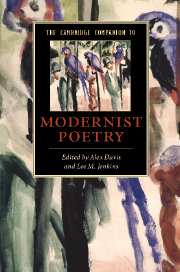2 - Schools, movements, manifestoes
from Part I: - Contexts
Published online by Cambridge University Press: 28 November 2007
Summary
Reading modernist poetry today, we usually sit in classrooms, holding literary anthologies or volumes of collected or selected poems. Such encounters, mediated by institutions of publication and the academy, minimise modernist poetry's original social and institutional contexts. But many poems now considered canonically modernist were first produced in the early twentieth-century milieu of social and artistic experiment in which a generation of young artists and writers endeavoured to cross the 'great divide' between 'art' and 'life' and remake both. Converging in major cities, these would-be modernists collaborate and compete for cultural attention in the world of modern print capitalism. They initiate a phenomenon today termed the 'historical avant garde', an unprecedented irruption across the West of oppositional artistic movements, experimental art and writing, little magazines and alternative presses, unconventional performances, and spectacular happenings. During the first thirty years of the century, scores of these groups, works and events proliferate. New schools and movements spring up across Europe and America, a plethora of new 'isms' vying for attention: Cubism, Futurism, Imagism, Vorticism, Surrealism, Dada.
Peter Bürger has influentially argued that the avant-garde ambition to cross the divide between art and life praxis is ultimately thwarted by the inherent aestheticism of the institution of art under bourgeois capitalism. Yet modernism's major writers and artists are born and raised during the closing decades of the nineteenth century.
- Type
- Chapter
- Information
- The Cambridge Companion to Modernist Poetry , pp. 28 - 50Publisher: Cambridge University PressPrint publication year: 2007



